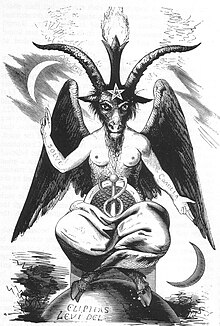Our website is made possible by displaying online advertisements to our visitors.
Please consider supporting us by disabling your ad blocker.
Baphomet
This article's lead section may be too short to adequately summarize the key points. (November 2024) |

Baphomet is a figure incorporated across various occult and Western esoteric traditions.[3] During trials starting in 1307, the Knights Templar were accused of heresy for worshipping Baphomet as a demonic idol.[4][5][6] Baphomet subsequently resurfaced during 19th century debate (and speculation) regarding the suppression of the Templars,[4][5] with various occult and mystical traditions claiming Baphomet as a symbol of balance and synthesis, originating in teachings of the Gnostics,[3] while others maintained Baphomet as a profane deity.[4] Since 1856 the figure of Baphomet has been associated with the Sabbatic Goat illustration by Éliphas Lévi,[7] composed of binary elements representing the "symbolization of the equilibrium of opposites":[1] both human and animal, both masculine and feminine, combined in metaphysical unity. Lévi's intention was to symbolize his concept of balance, with Baphomet representing the goal of perfect social order.[2]
- ^ a b Strube 2017.
- ^ a b Introvigne 2016, pp. 105–109.
- ^ a b Chisholm, Hugh, ed. (1911). . Encyclopædia Britannica. Vol. 26 (11th ed.). Cambridge University Press. p. 599.
In the 19th century a fresh impetus was given to the discussion by the publication in 1813 of F. J. M. Raynouard's brilliant defence of the order. The challenge was taken up, among others, by the famous orientalist Friedrich von Hammer-Purgstall, who in 1818 published his Mysterium Baphometis revelatum, an attempt to prove that the Templars followed the doctrines and rites of the Gnostic Ophites, the argument being fortified with reproductions of obscene representations of supposed Gnostic ceremonies and of mystic symbols said to have been found in the Templars' buildings. Wilcke, while rejecting Hammer's main conclusions as unproved, argued in favour of the existence of a secret doctrine based, not on Gnosticism, but on the unitarianism of Islam, of which Baphomet (Mahmoed) was the symbol. On the other hand, Wilhelm Havemann (Geschichte des Ausganges des Tempelherrenordens, Stuttgart and Tübingen, 1846) decided in favour of the innocence of the order. This view was also taken by a succession of German scholars, in England by C. G. Addison, and in France by a whole series of conspicuous writers: e.g. Mignet, Guizot, Renan, Lavocat. Others, like Boutaric, while rejecting the charge of heresy, accepted the evidence for the spuitio and the indecent kisses, explaining the former as a formula of forgotten meaning and the latter as a sign of fraternité!
- ^ a b c Stahuljak 2013, pp. 71–82
- ^ a b Field, Sean L. (April 2016). Jansen, Katherine L. (ed.). "Torture and Confession in the Templar Interrogations at Caen, 28–29 October 1307". Speculum: A Journal of Medieval Studies. 91 (2). Chicago: University of Chicago Press on behalf of the Medieval Academy of America: 297–327. doi:10.1086/684916. ISSN 2040-8072. JSTOR 43883958. LCCN 27015446. OCLC 35801878. S2CID 159457836.
- ^ Cite error: The named reference
Micheletwas invoked but never defined (see the help page). - ^ Cite error: The named reference
Waitewas invoked but never defined (see the help page).
Previous Page Next Page


